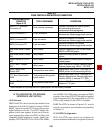
5-26
INSTALLATION-DK 16 KSU & PCB
SECTION 100-816-205
MARCH 1993
1) Remove the PCB from its protective packag-
ing.
NOTE:
The dB PAD switches SW101 through SW401
control excessive loudness resulting from close
proximity to the CO or PBX telephone office by
providing a 3 decibel (dB) signal level drop to, or
from, the PBX or CO when set to the 3 position.
Switches are factory-set to the 0 (0 dB signal
level drop) position.
2) If the Expansion Unit is located within one mile
of the PBX or CO telephone office, set dB PAD
switches SW101 through SW401 to the 3 (-3
dB signal level drop) position.
3) Insert the PCOU into the appropriate slot
(refer to Paragraph 2.22), and apply firm,
even pressure to ensure proper mating of
connectors.
4) After installing the PCOU, gently pull the PCB
outward. If the connectors are properly mated,
a slight resistance will be felt.
11.30 PCOU Wiring
11.31 Refer to PCOU Wiring Diagram, Section
100-816-208, for wiring/interconnecting details.
11.40 PCOU Programming Overview
11.41 The following parameters may be specified,
through programming, for the PCOU:
Program 03
Specify code 11 for the slot in which the PCOU
is installed.
Program 10-1
Allows/denies two-CO Line Conference and Di-
rect Inward System Access (DISA).
Program 15
Assigns DTMF/Dial Pulse (DP) Dialing, Tenant
Service, DISA, and other attributes to each CO
line.
Program 16
Assigns CO lines to groups 81 ~ 88, and dial 9
group.
Program 40
Assigns stations access to CO lines (incoming
and outgoing access).
FIGURE 5-17
PCOU CONTROLS, INDICATORS, AND INTERFACE CONNECTORS
SW301
SW201
BACKPLANE CONNECTOR
SW401
SW101
0 3
PAD
0 3
PAD
0 3
PAD
0 3
PAD
CO LINE MODULAR
JACK CIRCUITS 1 AND 2
CO LINE MODULAR
JACK CIRCUITS 3 AND 4
CO LINE
LED'S
1 2 3 4


















